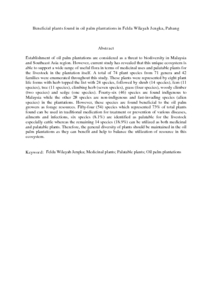Citation
Shaipudin, Nor'izzati and Go, Rusea and Zulkifli, Syaizwan Zahmir
(2014)
Beneficial plants found in oil palm plantations in Felda Wilayah Jengka, Pahang.
Acta Biologica Malaysiana, 3 (1).
pp. 24-34.
ISSN 2232-1675
Abstract
Establishment of oil palm plantations are considered as a threat to biodiversity in Malaysia and Southeast Asia region. However, current study has revealed that this unique ecosystem is able to support a wide range of useful flora in terms of medicinal uses and palatable plants for the livestock in the plantation itself. A total of 74 plant species from 71 genera and 42 families were enumerated throughout this study. These plants were represented by eight plant life forms with herb topped the list with 24 species, followed by shrub (14 species), fern (11 species), tree (11 species), climbing herb (seven species), grass (four species), woody climber (two species) and sedge (one species). Fourty-six (46) species are found indigenous to Malaysia while the other 28 species are non-indigenous and fast-invading species (alien species) in the plantations. However, these species are found beneficial to the oil palm growers as forage resources. Fifty-four (54) species which represented 73% of total plants found can be used in traditional medication for treatment or prevention of various diseases, ailments and infections, six species (8.1%) are identified as palatable for the livestock especially cattle whereas the remaining 14 species (18.9%) can be utilized as both medicinal and palatable plants. Therefore, the general diversity of plants should be maintained in the oil palm plantations as they can benefit and help to balance the utilization of resource in this ecosystem.
Download File
![[img]](http://psasir.upm.edu.my/36626/1.hassmallThumbnailVersion/Beneficial%20plants%20found%20in%20oil%20palm%20plantations%20in%20Felda%20Wilayah%20Jengka.pdf)  Preview |
|
PDF (Abstract)
Beneficial plants found in oil palm plantations in Felda Wilayah Jengka.pdf
Download (84kB)
| Preview
|
|
Additional Metadata
Actions (login required)
 |
View Item |

